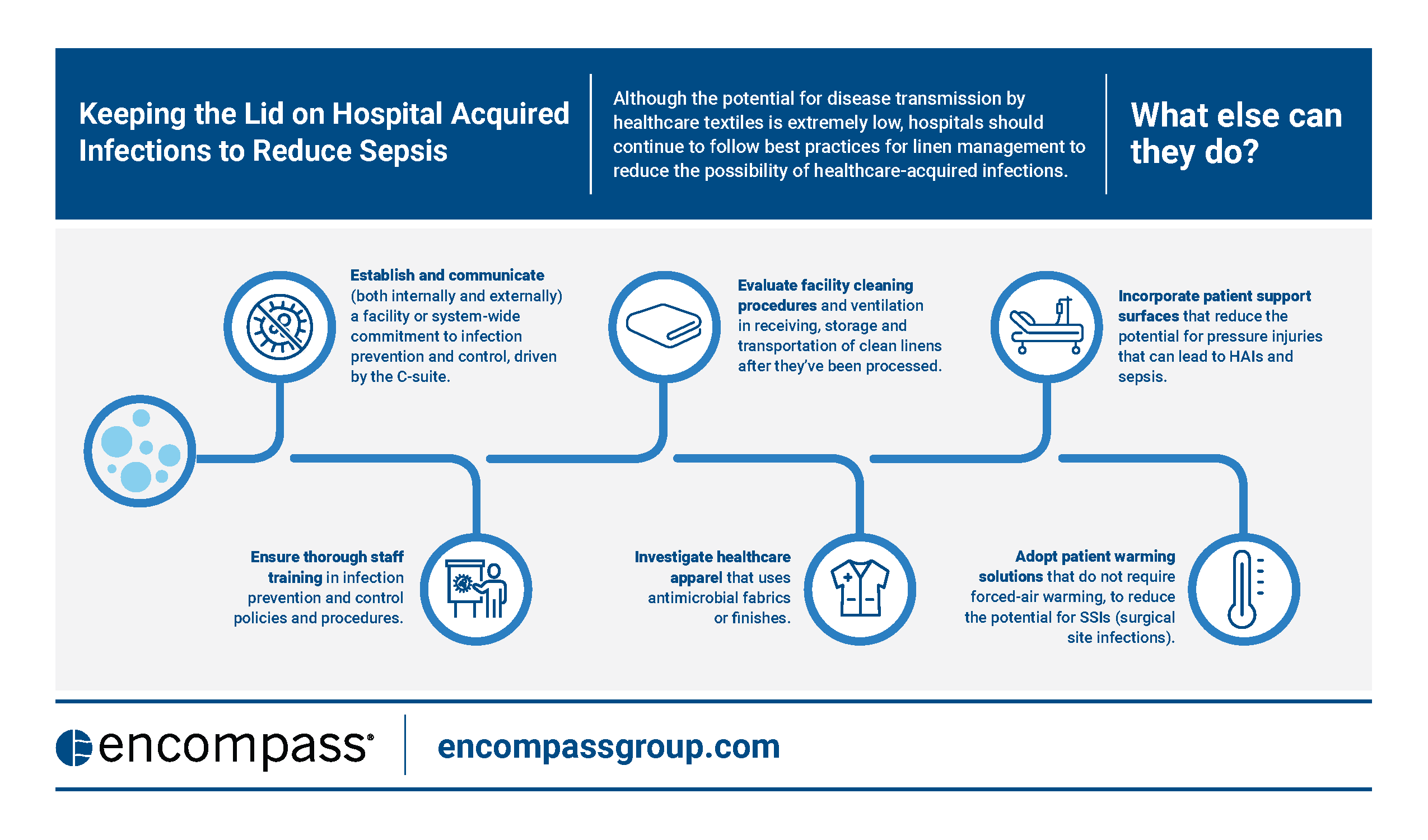By Kristy Warren, Director, Clinical Resources,
Encompass Group, LLC
According to the Centers for Disease Control and Prevention (CDC), one in 25 hospital patients develops a hospital-acquired infection (HAI) every year – and many of these infections lead to complications such as sepsis. While sepsis develops not only from HAIs, and not all HAIs become septic, reducing HAIs is an important goal in lowering the incidence of sepsis. With Sepsis Awareness Month taking place in September, let’s look at the connection between healthcare textiles and HAIs, the potential for opportunistic infections, and what steps hospitals can take to reduce the incidence of HAIs - keeping their patients safer and their reputations intact.
Healthcare Textiles As Fomites
In recent years, questions have been raised about the safety of healthcare textiles (HCTs) and their potential role in disease transmission, despite a statement from the CDC that the actual risk is negligible1. In addition to concerns with laundering, storage, and distribution processes, the role that actual fabrication of textiles could play has also been discussed. Whether seeking to prevent HAIs or identifying the source of a specific HAI or outbreak, HCTs have come under scrutiny as a potential source of contamination.
According to the International Journal of Environmental Research and Public Health, “Healthcare institutes are obligated to ensure all necessary measures to prevent or limit the spread of healthcare associated infections. One of the possible vehicles of transmission is inanimate fomites such as textiles.”2 Numerous studies have been conducted to determine if textiles are indeed contributors to disease transmission. Other research has attempted to discern whether textiles constructed of particular fibers, such as cotton, polyester, or blends of both, are more or less likely to attract or hold onto pathogens.
Tests have proven that microbes can survive on cotton, polyester, and blended fibers. In its white paper entitled, “Moment of Truth: Proper Air Flow Critical To Healthcare Laundries,” the Healthcare Laundry Accreditation Council confirmed that textiles “can be considered a fomite, an object capable of carrying an organism and serving as a reservoir that can be involved in transmission.”3 Research reported in the Journal of Clinical Microbiology showed that “VRE and MRSA injected into sterile textiles can survive anywhere from one to 90 days, provided that the textile has not been cleaned, laundered or otherwise decontaminated during that time.”4
Microorganisms Don’t Always Cause Infection
However, that same article also noted that the presence of infectious microorganisms on fabrics or surfaces does not necessarily translate to infection transmission, since “proper laundry processing protocols and guidelines reduce the likelihood that such microbial transfer will occur by reducing the numbers of microorganisms remaining on the surface or fomite.”5 Multiple studies have supported that, noting that specific conditions must be present for those microorganisms to be passed on and result in an HAI.
The CDC explains that, “transmission occurs when the agent leaves its reservoir or host through a portal of exit, is conveyed by some mode of transmission, and enters through an appropriate portal of entry to infect a susceptible host.” The chain of infection defines key elements that all must be present for pathogen transmission:
- There must be an adequate number of pathogens
- For HCTs to act as reservoirs, they must come into contact with virulent or potentially harmful pathogens
- There must be an opportunity to introduce the virulent pathogens to a susceptible host or patient; i.e. one with a weakened immune system
- The transmission or transfer of the organism must occur in sufficient numbers to cause disease, most likely through hand contact or contact with other contaminated objects.
This transfer creates the opportunity for the pathogen to take up residence in a susceptible host or patient, multiply, and cause an HAI, also known as an “opportunistic” infection.6
To Reduce Risk, Proper Processing is Essential
In its “Guidelines for Environmental Infection Control in Healthcare Facilities,” the CDC calls the risk of infection from HCTs “negligible” – as long as the textiles are handled, transported, and laundered safely. It recommends common-sense hygienic practices for linen laundering and storage, instead of imposing strict rules and regulations.7 For example, it makes sense that microorganisms can survive washing cycles if the water temperature is not sufficient to kill them, or the washing and rinsing cycles are too short. Commercial laundries therefore use scientific processes and best practices to hygienically clean HTCs.
Writing in Infection Control & Hospital Epidemiology, the CDC’s Dr. Lynne Sehulster emphasized that, “Current infection prevention strategies and textile management during patient use appear to be adequate in preventing HAIs, provided that every step is taken to maintain the hygienic quality of HCTs before use. Patient-to-patient transmission of microorganisms involving clean textiles has not been demonstrated to date, despite the fact that pathogenic microorganisms can survive on textiles.”
Since 1970, HCTs have been implicated in the spread of disease only 13 times worldwide! Just three of those cases occurred in the United States, all linked to breakdowns in transportation, storage, and distribution processes. Dr. Sehulster also pointed out the challenge of measuring such a “rare event,” given the estimated five billion pounds of textiles processed annually by healthcare laundry facilities.8

- https://www.cdc.gov/infectioncontrol/guidelines/environmental/background/laundry.html
- https://www.ncbi.nlm.nih.gov/pmc/articles/PMC3499872/
- https://590ba01b-dcbf-4e77-94ad-ad2a3ff26d55.filesusr.com/ugd/0feb29_5cdf177ce2994af298f3c0682e5990cd.pdf
- https://www.ncbi.nlm.nih.gov/pmc/articles/PMC86187/
- https://www.ncbi.nlm.nih.gov/pmc/articles/PMC86187/
- https://www.cdc.gov/csels/dsepd/ss1978/lesson1/section10.html
- https://stacks.cdc.gov/view/cdc/45796
- Sehulster, Lynne M.. “Healthcare Laundry and Textiles in the United States: Review and Commentary on Contemporary Infection Prevention Issues.” Infection Control & Hospital Epidemiology 36 (2015): 1073 - 1088
###

